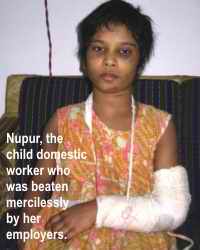Mdieval Savagery: Young girls, women and children
The latest victim of this savagery across the country is only 15 years old. Fancy Begum had been working as a maid at a house in Mohammadia Housing Society. While getting back home one day, she met a woman named Rosna who coaxed her into going to a nearby house. As soon as she got into the house on 5/14 Salimullah Road, Shayesta Shajid, the mistress, and her brother, Miraj, locked Fancy up. "I begged them to let me go; but they wouldn't listen to me," Fancy says. Meanwhile, Rosna, the dalal, who lives on supplying young girls like Fancy to different houses in the neighbourhood, had disappeared. Fancy never saw her again.
Within four days, Fancy was beaten with a curtain rod. "They both (Shayesta and Miraj) beat me up that day because I had broken an expensive plate," she says.The most brutal and savage attack took place on August 5, 2004 last year when the mistress and her brother hit her on the head with a big stick. "Blood started to ooze out; I cried for help and when the neighbours came, the Begumsahiba told them to back off," says Fancy. "She is our maid and we will do with her whatever we want to," Shayesta Shajid, herself a mother of two, told the neighbours.
For Fancy, things got even worse after the incident. Whenever she broke anything while cleaning or dusting, Miraj would slap her or pull clusters of her hair out as punishment. Apart from this medieval form of torture, both the brother and sister scalded her with a smouldering khunti (kitchen utensil). Fancy's entire body bears the marks of burn and torture. Fancy was never given any medicine or taken to a doctor. She shows the gaping, infected wound on her left shoulder.
Then, on January 24, they decided to get rid of her. "That day, Miraj threatened me several times and told me that they would kill me," Fancy says. She continues, "They tied a piece of cloth over my eyes, sealed my mouth with tape so that I couldn't shout and took me to a rickshaw." Fancy did not have any idea where the rickshaw was heading because she was forced to bend her head down in between the abuser-duo. When they reached Hazaribagh, on the Buriganga, they pushed her onto the riverbank.
When the torturers were gone, perhaps thinking she was dead, Fancy freed herself and walked up the edge to the street. Severely injured and lost, Fancy walked down Hazaribagh where she was rescued by a group of patrolling policemen.
Although sexual abuse of domestic workers is very common, very few cases get reported, while even fewer lead to convictions. Social stigma and poverty are big deterrents for victims to seek justice. But even when they do seek help from the law, legal loopholes and corruption of individuals having key roles in the legal process, leave the victim with nothing but memories of their trauma.
But why are domestic workers particularly vulnerable? One major reason is that they are 'invisible', with no organisation to represent them and are not registered as part of the work force. They are completely at the mercy of their employers and a brutal feudal system where employers feel they are superior to their domestic workers and so have the right to do whatever they want with them. Apart from the incidents of systematic, sadistic torture, in many instances the domestic worker does not get enough to eat and little or even no pay. This kind of modern day slavery is perpetuated by society's tacit acceptance of class discrimination. There is an implicit conspiracy of support among individuals of the privileged classes.
In almost every household that employs domestic workers, there are incidents of verbal or physical abuse. It is just a matter of degree. Sometimes it may be in the form of a slap or verbal humiliation. At other times it gets more violent and brutal. Some of us feel outraged by the contempt and injustice meted out to people who essentially make our lives easier and more comfortable. Very few of us stand up for them and stop our family-members even when they are committing these crimes right before our eyes.
The disconcerting truth is that many employers will continue to mistreat and torture their domestic help. Right at this moment, some child or some woman, somewhere is being brutally beaten or maimed with an iron rod, or a heated utensil or a rolling-pin or some other object. They are all isolated cases but eerily similar. The pattern of violence points to a social malaise going out of control. It also demonstrates that unless these criminals, who walk around in the guise of respectability, are exposed publicly and are punished by the legal system, there is no hope for thousands of hapless domestic workers trapped within the sadistic web of their perverted employers (A. M. Amin, A. Hussain and K. S. Islam, Daily Star, Feb. 12, 2005).

